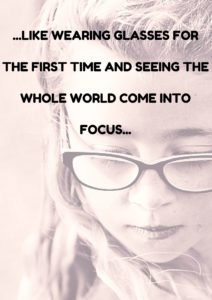Orton-Gillingham started over seventy years ago as an instructional approach intended for those with difficulty reading, spelling, and writing, like what children experience in dyslexia. Sometimes, teachers recognized the special needs of a reading-challenged student, but just as often, it was blamed on disinterest or lack of effort, leaving the child to conclude s/he “just wasn’t good at reading.” When those same children were taught to read using the Orton-Gillingham (O-G) approach, many felt like that child who puts glasses on for the first time and his/her entire world comes into focus.
Since then, the Orton-Gillingham Method has enabled thousands of children to access worlds opened to them by reading, something they never thought would happen. In fact, it has been so successful, O-G is being mainstreamed into the general education classroom, as a way to unlock the power of reading for more students.
 What is Orton-Gillingham?
What is Orton-Gillingham?
Orton-Gillingham (officially labeled “Orton-Gillingham Multisensory Structured Language Approach”) came about through the foundational contributions of Samuel T. Orton and Anna Gillingham. Orton was a neuropsychiatrist and a pioneer in focusing attention on reading failure and related language processing difficulties. As early as 1925 he identified dyslexia as an educational problem. Anna Gillingham was a gifted educator and psychologist. Encouraged by Dr. Orton, she compiled and published instructional materials which provided the foundation for what became known as the Orton-Gillingham Method.
Orton-Gillingham is not a packaged curriculum, rather a prescriptive program designed for each individual student. The O-G teacher incorporates phonology and phonological awareness, sound-symbol association, syllable instruction, morphology, syntax and semantics into a personalized methodology using the following approaches:
- studying sounds and how they work within the environment
- learning the sounds of the English language and their correspondence to letters that represent those sounds
- understanding morphemes (smallest units of meaning in language)
- studying base words, roots, prefixes and suffixes
- understanding the principles that dictate the sequence and function of words to convey meaning (grammar, sentence variation, and mechanics of language)
- studying the aspects of language concerned with meaning
These are taught using visual, auditory, tactile, and kinesthetic tools and serve as the basis for a one-on-one instructor-student learning environment that teaches the connections between sounds and letters.
How has it been mainstreamed?
While O-G is most often associated with the remediation of struggling readers, recently it’s expanded to a whole-classroom setting (with adaptations). Statistics such as the ones below have forced education specialists to accept that reading programs in place in the typical classroom fail far too many students*:
- Only 32% of the nation’s public school students in 4th grade performed at or above grade level (NAEP, 2011).
- Of low-income 4th graders, 50% read below basic level (NAEP, 2011).
- Nationally, there is no significant change in 4th grade reading scores from 2011-2013 (NAEP, 2013).
(* data from the Stern Center for Language and Learning)
Studies have shown that O-G’s multisensory, kinesthetics, and tactile techniques not only succeed with reading-challenged students but all students. Because it isn’t often taught in teacher training programs (at least, not in depth because it is considered a special needs program by many), it requires additional professional development to unpack the dynamic traits. Schools that have taken that training step find their students read better, unpack new words more effectively, and comprehend the fullness of the text they are reading
 5 Steps to using it in your classroom
5 Steps to using it in your classroom
If you’re planning to use the Orton-Gillingham Method in your school, plan to:
Follow a multi-step program
O-G believes learning to read follows a logical order. Rather than picking any book, students advance through levels, mastering one before moving on. They go from simple to complex, known to unknown, predictable to unpredictable, along the way developing confidence in themselves that they can do this thing called reading.
Learn in small groups
Students learn in small groups or 1:1, even in a whole classroom setting. Each student is unique and their needs are individual, but some can be grouped together into a small learning group.
Be flexible in adjusting to various learning styles
When students struggle with reading, teaching using visual, kinesthetic, auditory, and tactile tools provides many options for communicating ideas. O-G teachers have all of these available to them when instructing readers. If one doesn’t work, they try another, agilely differentiating for varied learning styles as needed.
Train teachers
To deliver O-G effectively requires teacher training. The Method is not intuitive and differs in significant ways from traditional reading programs learned in teacher-training programs. These can be taken through a provider like IMSE or another trained professional.
***
Teachers who use O-G often relay that they get a sense of coming home. Its focus on touch and feel, using sand trays, and tracing letters, provides them with sensible natural tools that reach more students than traditional methods. For an overview, watch these videos on two schools’ experiences applying O-G to a whole classroom:
IMSE: Orton-Gillingham in General Education from Kristen Akers Gozdecki on Vimeo.
More on reading:
Ten Reading-with-Tech Tips You Don’t Want to Miss
How do I create a classroom library checkout system?
5 Tech Tools to Inspire Reading
More on Big Ideas in education:
How to Incorporate Mindfulness into Your Class
How to Blend DoK into Lesson Plans without a Comprehensive Rewrite
Use the SAMR Model to Spearhead Technology in Your Classroom
Jacqui Murray has been teaching K-18 technology for 30 years. She is the editor/author of over a hundred tech ed resources including a K-12 technology curriculum, K-8 keyboard curriculum, K-8 Digital Citizenship curriculum. She is an adjunct professor in tech ed, Master Teacher, webmaster for four blogs, an Amazon Vine Voice, CSTA presentation reviewer, freelance journalist on tech ed topics, contributor to NEA Today, and author of the tech thrillers, To Hunt a Sub and Twenty-four Days. You can find her resources at Structured Learning.





































Thank you, thank you, thank you for posting about this wonderful approach to teaching reading. I am a teacher/tutor that uses an O-G based approach with my students and have seen significant gains in a short amount of time. I can’t say enough about O-G…..IT WORKS!
So good to hear about your success. O-G has a reputation for special needs, but it’s grown much beyond that. I’m glad you shared your support.